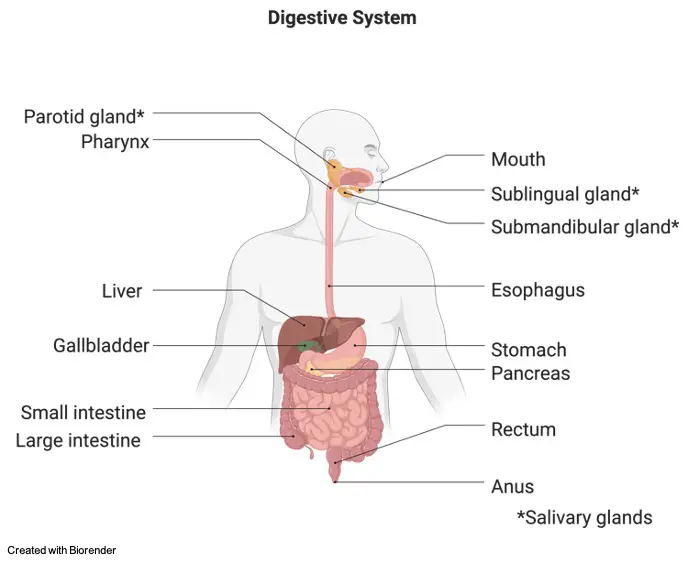What is Digestive System?
Living organisms consume food to maintain a proper condition of our body and becomes essential for survival. An ideal diet is required to meet daily requirements of our body.
Body homeostasis (constant functioning of body) is achieved by the food we eat daily.
Nutrition is the processing of food material into basic components such as Amino Acid, Carbohydrate, Fats, Vitamins and Minerals.
All these components are absorbed and utilized later in stomach and intestine. The nutrition provides raw materials for metabolic activity to produce energy in the form of ATP.
ATP then drives our body mechanisms to build, protect and provide fuel for maintaining the stability.
Though carbohydrates provide 70 – 80% of the energy, Lipids (fats) contributes about 20% of the energy and are interconvertible to certain forms which makes it an ideal compound to store in body at Adipose tissues.
When our body requires energy the storage fats are broken down and enters metabolic cycles to provide ATP.
When require fats produces precursor (early compound form of any substance which on breakdown or activated to give a desired molecule.
For example: retinol which is converted into RETINAL – a structural component in vision) for Vitamin A and Vitamin D.
Parts of Digestive System
I. Mouth
Mouth has an enzyme called Lingual Lipase. Lingual lipase is not effective in breaking down all fat present in food. It reduces small amount of fats into smaller components.
Lipase is one of the constituents of saliva. The minimal breakdown of fats and mechanical chewing of food along with the help of muscle; the food now becomes bolus.
II. Oesophagus
The bolus is now transported in the long tube to the stomach by the action of peristalsis an involuntary mechanism which moves the food particle to stomach.
III. Stomach
Bolus when reaches stomach and acted by gastric enzymes bolus becomes chyme. Stomach contains Gastric lipase. Gastric lipase along with HCl emulsifies the fats results in Fat Emulsion. Fat Emulsion enters small intestine for further digestion.
Intestine and Associated Organs
Fats are not easily digested by stomach and mouth. When fats enter intestine its associated organs such as Pancreas and Liver produces lipase and Bile salts respectively.
A special feature of fats is that they are hydrophobic (i.e.) they are insoluble in water. In order to digest then the bile salts and liquid produced by liver mixes the immiscible fat substances into small clusters of molecules.
Pancreatic lipase mixes along bile and forms many digestive products namely: Free fatty acids, Mono acyl glycerol, Cholesterol and Long Chain Fatty Acid.
The bile salts combine with lipids to form a micelle. Micelle is water soluble structure which easily absorbs fats.
Micelle Formation
Micelle now provides surface area to fat breakdown. Thus, the formation micelle with bile salts and pancreatic lipase is Fat Emulsification.
Emulsification of fats takes place in intestine which are later taken into enterocytes – the intestinal cells.
Transport of Micelle is done through 2 ways:
1. Diffusion: movement of fat molecules because of the difference in the concentration. The concentration of micelle outside the enterocytes are high and inside the cells are low. Because of this difference, the micelle is transported to low concentration region.
2. Protein Carrier Transport: certain proteins present in the cell membrane will take up micelle and enter it into the cells.
On entry, the micelle reaches the endoplasmic reticulum present inside enterocyte. In endoplasmic reticulum; Apoproteins acts on the micelle and forms CHYLOMICRONS. Chylomicrons are substances which transports micelle to the lacteal and blood vessels present outside the cell.
Lipid Digestion
Most of the lipids present in chylomicron enters lacteal vessels; a part of lymphatic system. After circulating in the lymphatic system, they travel to circulatory system using certain proteins for their transportation.
Some part of lipids enters certain organs for breakdown of lipid into energy. Other part of lipids reaches adipose tissues in the skin.
In Adipose Tissue, the fats namely glycerol, free fatty acids on esterification (i.e.) alcohol and ester forms a product becomes Triacylglycerol which is stored till its requirement.
When the fats are required for energy production triacylglycerol on lipolysis (i.e.) breakdown of lipids forms Free Fatty Acids and Glycerol and moves back to organs for ATP production.
You may like to read;
Krebs Cycle: Definition, Diagram, Steps, and Mechanism
Mitochondria: Function, Definition, Significance, and Facts
Calvin Cycle: Definition, Diagram, Mechanism, and Steps
Oxidative Phosphorylation: Definition, Function, Significance, and Facts
Digestive System Citations
- The digestive system. Nurs Mirror . 1984 Apr 11;158(15):23-5.
- Digestive system. Annu Rev Physiol . 1959;21:183-210.

